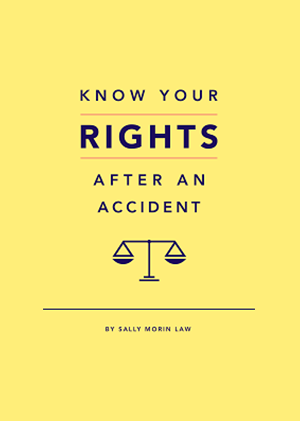California drivers are required, at a minimum, to have at least $15,000 of liability insurance coverage available for when they cause a person bodily injuries in a motor vehicle accident. California Vehicle Code § 16056(a). Unfortunately, $15,000 does not go very far when an injured party has suffered injuries that require emergency treatment and ambulance transportation to the emergency room. It is not uncommon that these bills alone amount to $10,000 or more. Thus, when an injured party suffers broken bones, or injuries necessitating surgery, $15,000 of insurance coverage is not nearly enough to cover the individual’s medical expenses, let alone deprives them of compensation of their loss of earnings, transportation expenses, and pain and suffering. Even higher liability insurance limits of $30,000 and $50,000 leave severely injured parties uncompensated for a large majority of their losses related to the accident, which undermines the purpose of tort law—to make an injured party “whole,” i.e. attempt to put them in the same position they were prior to the accident.
Carrying Sufficient Insurance Coverage is in Your Own Benefit
Accidents happen – hence the need for insurance. Having adequate insurance coverage is important for two reasons – to ensure that it adequately compensates an injured party for their losses due to an accident that you may have caused, and to shield yourself from personal liability. If you find yourself in a scenario where you have insufficient automobile coverage for an accident you are responsible for, you are placing your personal assets at risk. Assets that may be at risk include: money in your checking and savings account, employment income, home ownership, stock and bond ownership, and inheritance monies, just to name a few. In order to ensure that your assets are adequately protected, it is important to have insurance coverage that is, at a minimum, proportional to your worth. Thus, the more assets you have, the more insurance you should have in order to protect yourself.
When Insurance Coverage does not Compensate an Injured Party We ask for an Asset Declaration
When we are faced with a policy limits issue (i.e., not enough insurance coverage to cover all of the damages caused in the accident) in a client’s case, we always inquire into the at-fault party’s assets. Typically, a person with minimal insurance limits has little or no assets worth protecting, and thus no other feasible source of recovery is available for them in a given case. However, despite this commonality, we always make sure to protect our client’s interests by ruling out the possibly that the at-fault party does have viable assets worth pursuing.
Thus, prior to closing out a policy limits cases, our legal team conducts an online investigation into the third party’s ability to pay amounts above their insurance coverage. This includes a search of their real property holdings and employment status. We also require that the at-fault party complete an Asset Declaration disclosing their assets prior to accepting their insurance policy as payment in full for the case. Specifically, we ask for disclosure of any interest in any property, stocks, and trusts, amount of money in checking and savings accounts, other available insurance coverages, and so on. If a given Asset Declaration reveals that a person has viable assets worth pursuing, and the policy limits leave our client uncompensated for the losses they endured as a result of an accident, than it provides an additional avenue of recovery for us to pursue for our client. This will likely be a lengthy route, as requires us to file a personal injury lawsuit against the individual personally, and in all likelihood will require litigation and trial. This is always the last possible case scenario—as it is never fun to sue an individual personally for a mistake that they made, reiterating why it is so important to carry adequate insurance coverage, because personal injury accidents do inevitably happen.
Why Would a Person Willingly Disclose they have Assets?
Given the intrusive nature of an Asset Declaration, oftentimes an at-fault party will refuse to complete it, partially or at all. If this occurs, we then discuss with our client whether or not we should hire an investigator to dig into the at-fault party’s assets, as it will increase their case costs by a few hundred dollars. This is almost always a good idea, even if it is just to rule out the possibly that there are assets worth pursuing, as well as allows a client to sleep at night knowing that that we have exhausted all possible avenues of recovery for their case.
The Ramifications of a Dishonest Asset Declaration are Not Severe
By completing and signing an Asset Declaration, a person is taking an oath that the information that they have disclosed is truthful. The oath is taken very seriously, and if a person is dishonest and provides inaccurate information on their Declaration, then they have committed two offenses: perjury and fraud.
Perjury is a criminal offense that is subject to prosecution. California Penal Code § 118. The reality, however, is that civil (which is the law governing personal injury cases) perjury is rarely (if ever) prosecuted, and even if it were, it would sanction the person’s dishonest behavior (make them pay the Court) rather than remedy the injured party in a personal injury suit. Thus, attempting to prosecute an individual for a perjured declaration does not provide a remedy for the party whom the asset declaration affects.
Providing dishonest information on an Asset Declaration also constitutes fraud, which is a civil offense. There are two types of fraud: extrinsic fraud and intrinsic fraud. Extrinsic fraud occurs when a party was “deprived of its opportunity to present a claim or defense to the court or where it was kept in ignorance or fraudulently prevented in some other manner from fully participating in a proceeding.” Heyman v. Franchise, 107 Cal. App. 4th 921, 926 (Cal. App. 4th Dist. 2003). California courts view extrinsic fraud as “the excusable neglect of a party,” and provide remedies for the injured party in a lawsuit. Alternatively, intrinsic fraud exists when a party has “had the opportunity to present its case and protect itself from any mistake or fraud of its adversary, but has unreasonably neglected to do so.” Heyman v. Franchise, 107 Cal. App. 4th 921, 926 (Cal. App. 4th Dist. 2003). Intrinsic fraud unfortunately does not provide a remedy for the party whom is affected by a dishonest declaration.
The California judiciary has determined that lying on a declaration constitutes intrinsic fraud. Their reasoning for this is, that by taking an asset declaration for face value, an attorney “[fails] to take advantage of liberal discovery policies to investigate his or her claim.” Id. This is further explained by the California Court of Appeal in Heyman v. Franchise: “An adverse party’s representation of the value of an asset favorable to that party constitutes intrinsic fraud, because only through the moving party’s inexcusable neglect would that party accept the valuation given by the adverse party without making his or her own investigation.” Id. In a separate, relevant case, the California Supreme Court found that an insurance carrier who misrepresented their insured’s policy limits in testimony and on documents was guilty of intrinsic fraud that was not remediable after trial on the merits. Home Ins. Co. v. Zurich Ins. Co., 96 Cal. 4th 17, 27 (2002).
Thus, intrinsic fraud, such as forging an asset declaration or misrepresenting assets in to a personal injury lawyer, is not remediable after the conclusion of a case. Instead, it the duty of the attorney to exhaust available resources, such as discovery and independent investigation, to ensure that an at-fault party does not have any viable assets worth pursuing prior to closing out and settling a policy limits case.
Ways for an Attorney to Preserve Remedies for a Fraudulent Asset Declaration
As explained above, after the conclusion of a case, a personal injury attorney has essentially waived the available remedies if he has taken an asset declaration for face value. However, prior to settling a case, an attorney can preserve a breach of contract action in the event that intrinsic fraud has been committed. The Economic Loss Doctrine: Intrinsic or Extrinsic Fraud, 99 Marq. L. Rev., 179, 207. In a personal injury case, an attorney can insert a clause into the Settlement Release stating that any and all representations that may have been made by the parties are the basis of the contract; i.e., that the claimant is relying on the information disclosed in the at-fault party’s asset declaration as the basis for settling the claim. Thus, if the at-fault party has lied or misrepresented their assets on the declaration, and that misrepresentation was the basis for setting the personal injury case and accepting the policy limits, a clause in the Settlement Release that voids the contract for such a misrepresentation can be used in a breach of contract action. Id. By doing this, the attorney will have done her due diligence to protect her client and preserve a breach of contract action in the event of a dishonest declaration and an intrinsic fraud determination by a court.
So, although Asset Declarations are no “guarantee” of an accurate picture of the third party’s assets, it is simply another tool we use to gather information for our client to make a decision about settlement in policy limits cases. We can enforce the truthfulness of the Asset Declaration (after the fact) by including the above-described language in the settlement release in our personal injury cases. We also conduct our own independent investigation as to a third party’s assets when the case calls for it. There are various tools that can be used to investigate a third party’s assets, but the bottom line is that even if those assets exist, they can easily be shifted around, spent, transferred or the third party can file for bankruptcy to avoid paying anything in a personal injury traffic accident case.
If you have any questions about policy limits or pursuing an individual for a bicycle, motorcycle, pedestrian or car accident case, you should consult with an experienced California personal injury lawyer right away.











